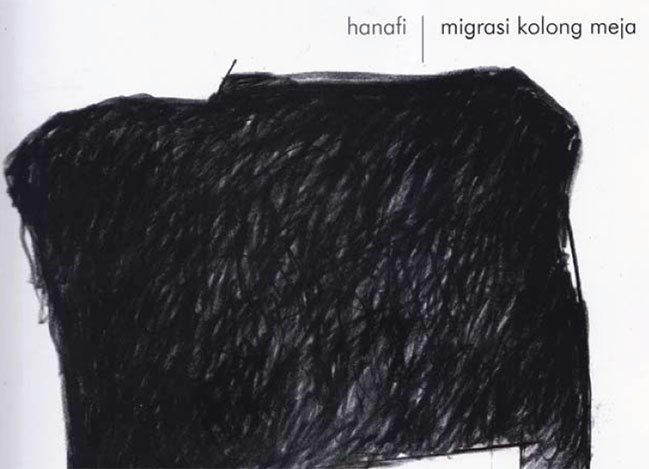Hanafi | Migrasi Kolong Meja
Migrasi Kolong Meja, a Hanafi’s desire to dismantle darkness, to expose falsehood through abstract paintings. Probably most people think, it is difficult to enjoy, to assess or to understand an abstract painting. But on the other hand, an abstract painting is considered to provide is unlimited space for the presence of perception. A painting is called an abstract because it does not represent real or concrete objects. On the surface of the canvas, only multicolored dashes, scratches and texture of paints, sometimes accompanied by melting paint and clear or spontaneous line graffiti are presented. Familiar and everyday objects that take their forms from environment are rare occurances in abstract painting. Observing an abstract painting is like standing at the center of unspoiled jungle, but also can be like being on the field of free space waiting to be explored. Meanings are formed in diverse ways.
History has it, the birth of abstract art was a response to the chaos that swept the world. Chaotic political, social and economy conditions, are reflected with the presence of a new art movement, abstract. Within modernistic framework, aesthetic enjoyment can create a distance to the reality that exists outside of art, so the formal principles or shapes are the standard for art assessment. This discourse was attacked by postmodernists who call abstract style as an “anti-humanist” art that marginalize political representation.
In Indonesia, abstract art owes its existance to modern Western influence. Abstract art experiencing an interesting development here, when combined with local spiritual culture. A sense that evokes by abstract art reaches deeper dimension. As any other abstracts painterin Indonesian, Hanafi, comes with a unique taste or character in his work. Hanafi was born in Purworedjo, a small town in Central Java. His introduction to abstract art began in academic education. The exhibition catalog of Migrasi Kolong Meja try to show something interesting from Hanafi’s paintings. In a writing for curatorial exhibition, Agung Hujatnikajennong highlights a wide themes from the birth abstract art, to the uniqueness Hanafi in abstract style world.
Amidst rapid currents of postmodern, Hanafi has a solid base with abstract style. Hanafi is trying to appear with different characters. If abstract formalism is identical with solving the problem of form through visual methodologies eg. visual-simplification, stylization or deformation of the object-Hanafi method is closer to a negation of the visual logic of objects. The special point of Hanafi’s abstract painting lies in his courage to explore abstract (not concrete or unspoiled). This exhibition catalog presents the an editorial Migrasi Kolong Meja, a space that is rarely noticed or discussed. Thing that exists under the table is a space that is still abstract. This editorial serves as a metaphor of darkness that can move, as if space and light has physical definite limits.
Hanafi has a desire to dismantle the darkness, so no more mystery floats around it. From the narrative in this catalog we are invited to understand abstract paintings by knowing background or ideas that moved an abstract painter. The look of abstract paintings tend to be simple, it seems to comprises with only knowledge of color and composition, but it was originated from a very complex idea. Undoubtedly the knowledge of background or idea of the artist, will enable us to see an abstract painting like seeing a realist painting.
Equipped with photos of Hanafi’s abstract paintings, adds perfection to this exhibition catalog. This catalog deserves to be read and known by observer and lover of art.
Book Title : Migrasi Kolong Meja
Painter: Hanafi,
Curator : Malna Afrizal and Agung Hujatnikajenong
Book Reviewer: Agus Eka Cahyadi,
Publisher : Semarang Gallery and Komaneka Fine Art Gallery,
Length : 60 pages
This book could be found at Komaneka Fine Art Gallery.

